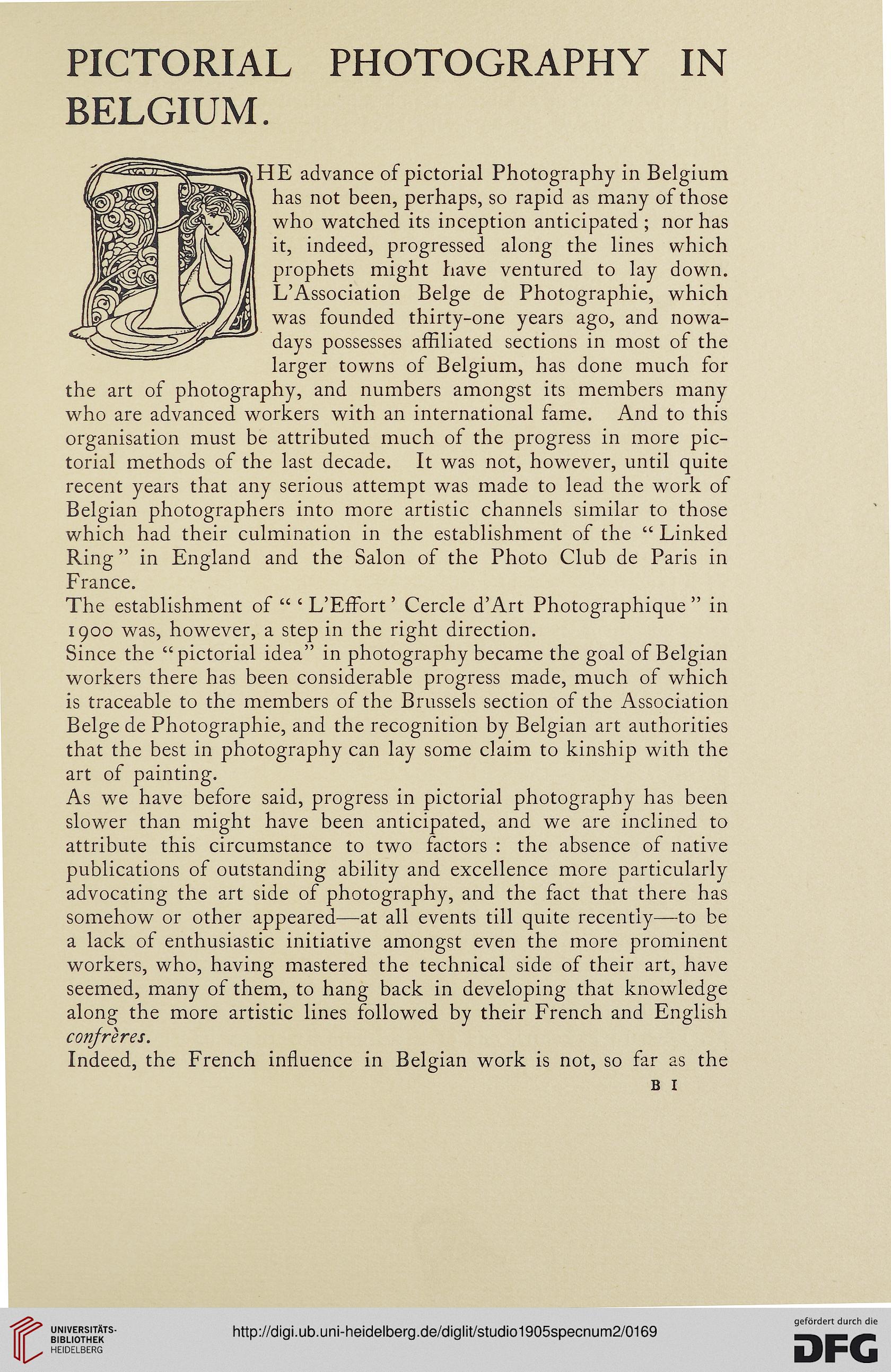PICTORIAL PHOTOGRAPHY IN
BELGIUM.
HE advance of pictorial Photography in Belgium
has not been, perhaps, so rapid as many of those
who watched its inception anticipated; nor has
it, indeed, progressed along the lines which
prophets might have ventured to lay down.
L’Association Beige de Photographic, which
was founded thirty-one years ago, and nowa-
days possesses affiliated sections in most of the
larger towns of Belgium, has done much for
the art of photography, and numbers amongst its members many
who are advanced workers with an international fame. And to this
organisation must be attributed much of the progress in more pic-
torial methods of the last decade. It was not, however, until quite
recent years that any serious attempt was made to lead the work of
Belgian photographers into more artistic channels similar to those
which had their culmination in the establishment of the “ Linked
Ring” in England and the Salon of the Photo Club de Paris in
France.
The establishment of “ c L’Effort ’ Cercle d’Art Photographique ” in
1900 was, however, a step in the right direction.
Since the “pictorial idea” in photography became the goal of Belgian
workers there has been considerable progress made, much of which
is traceable to the members of the Brussels section of the Association
Beige de Photographic, and the recognition by Belgian art authorities
that the best in photography can lay some claim to kinship with the
art of painting.
As we have before said, progress in pictorial photography has been
slower than might have been anticipated, and we are inclined to
attribute this circumstance to two factors : the absence of native
publications of outstanding ability and excellence more particularly
advocating the art side of photography, and the fact that there has
somehow or other appeared—at all events till quite recently—to be
a lack of enthusiastic initiative amongst even the more prominent
workers, who, having mastered the technical side of their art, have
seemed, many of them, to hang back in developing that knowledge
along the more artistic lines followed by their French and English
confreres.
Indeed, the French influence in Belgian work is not, so far as the
BELGIUM.
HE advance of pictorial Photography in Belgium
has not been, perhaps, so rapid as many of those
who watched its inception anticipated; nor has
it, indeed, progressed along the lines which
prophets might have ventured to lay down.
L’Association Beige de Photographic, which
was founded thirty-one years ago, and nowa-
days possesses affiliated sections in most of the
larger towns of Belgium, has done much for
the art of photography, and numbers amongst its members many
who are advanced workers with an international fame. And to this
organisation must be attributed much of the progress in more pic-
torial methods of the last decade. It was not, however, until quite
recent years that any serious attempt was made to lead the work of
Belgian photographers into more artistic channels similar to those
which had their culmination in the establishment of the “ Linked
Ring” in England and the Salon of the Photo Club de Paris in
France.
The establishment of “ c L’Effort ’ Cercle d’Art Photographique ” in
1900 was, however, a step in the right direction.
Since the “pictorial idea” in photography became the goal of Belgian
workers there has been considerable progress made, much of which
is traceable to the members of the Brussels section of the Association
Beige de Photographic, and the recognition by Belgian art authorities
that the best in photography can lay some claim to kinship with the
art of painting.
As we have before said, progress in pictorial photography has been
slower than might have been anticipated, and we are inclined to
attribute this circumstance to two factors : the absence of native
publications of outstanding ability and excellence more particularly
advocating the art side of photography, and the fact that there has
somehow or other appeared—at all events till quite recently—to be
a lack of enthusiastic initiative amongst even the more prominent
workers, who, having mastered the technical side of their art, have
seemed, many of them, to hang back in developing that knowledge
along the more artistic lines followed by their French and English
confreres.
Indeed, the French influence in Belgian work is not, so far as the




